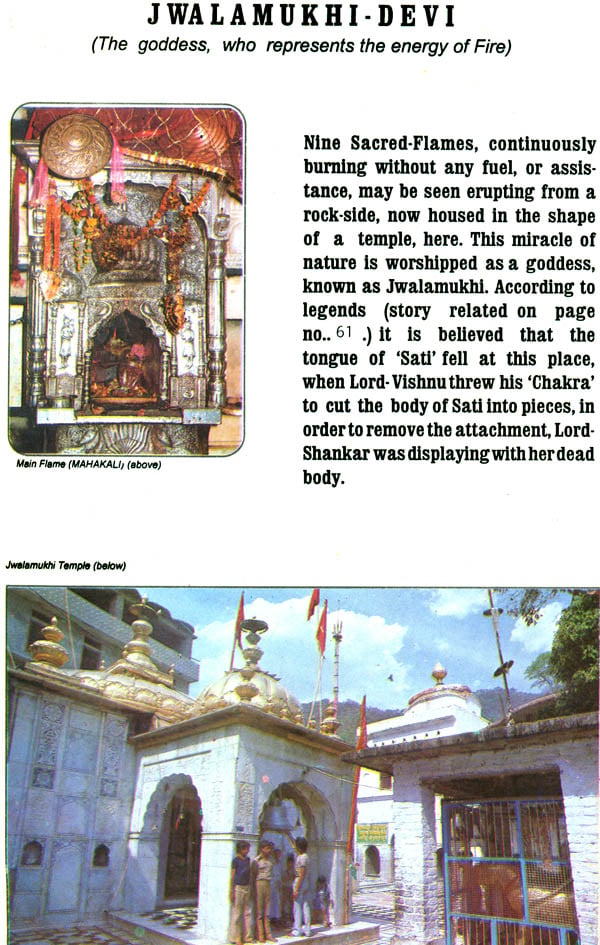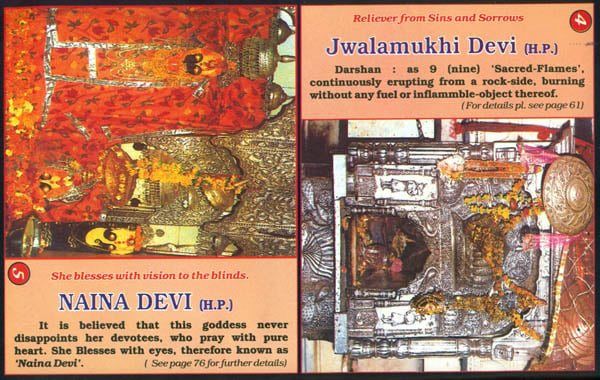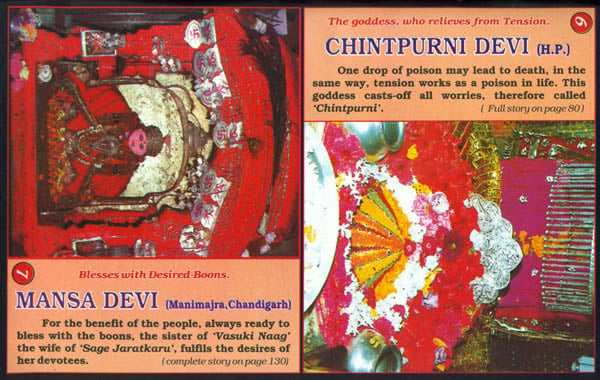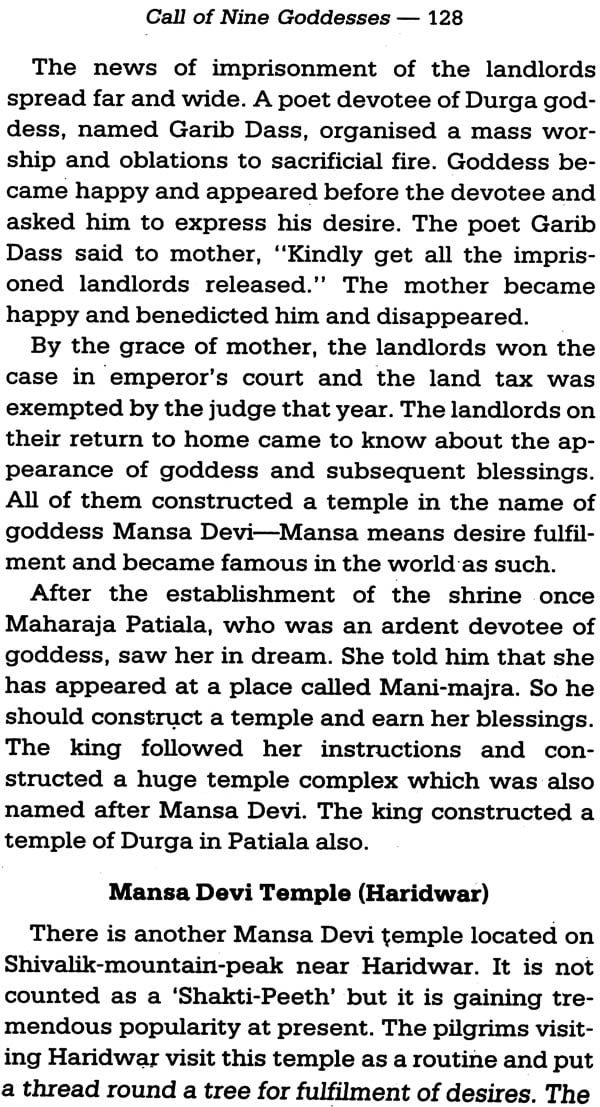
CALL OF- NINE GODDESSES: (1. Naina Devi, 2. Chintapurni, 3. Jwalamukhi, 4. Vajreshwari (Kangra), 5. Chamunda Devi, 6. Vaishno Devi, 7. Mansa Devi, 8. Kalika Devi, 9. Shakumbhari)
Book Specification
| Item Code: | IDG220 |
| Publisher: | PUSTAK-SANSAAR |
| Language: | English |
| Edition: | 2009 |
| Pages: | 152 (B & W Illus: 5, Color Illus: 35, Figures) |
| Cover: | Paperback |
| Other Details | 8.5"X5.5" |
| Weight | 250 gm |
Book Description
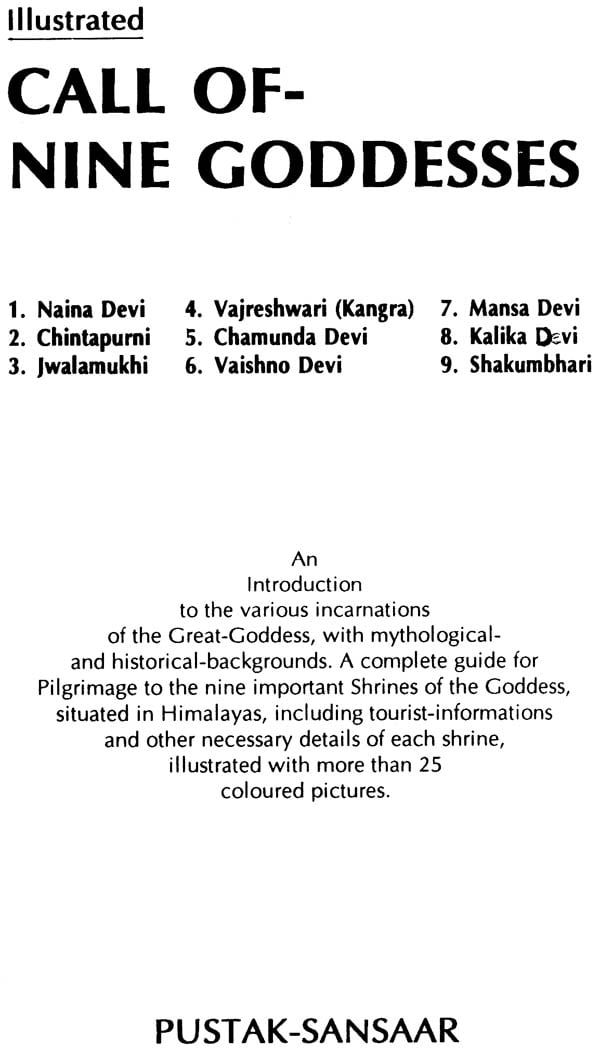
What is here is there and what is there is here. Things and beings seem various but are indeed one being. We are liberated when we perceive this oneness. We go from death to death if we perceive differences. It is by enlightenment that the mind can overcome the feeling of difference and have a vision of transcendent oneness in the form of divine mother Maheshwari.
As every object of this world is subject to limitations, so is the human intellect. But the divine force, which is in continuous action behind every subject and object, is beyond limitations and is as such known as Shakti or Tripura or Mahamaya. The same force becomes thought of the subject, action of the object and later the cause of the dissolution of both subject and object. The divine mother can be seen in numberless forms in the universe but still she is one and the only one.
An attempt has been made in this book "The Call of nine Goddesses" to present a true historical account of the holy shrines based on traditions and mythology. But an interesting aspect of the book is the importance of devotion for devotees. No aspect of worship is true without devotion. The love of the divine mother and her clarion call to devotees Mata Ne Bulaya Hai fills nectar in the heart and soul of pilgrims and devotees make bee-line to lick the divine nectar, there-of shrills of joy and devotion fill the air "Jai Mata Di". There is no distinction of sex, caste, language, religion, belief or anything. One has to only call the divine mother and she will fulfil desires and give joy without fail.
It is a profound experience to read this exposition. It has its historical elements, geographical pointers, aesthetic excellence.
Once again, I thank and bow down to the inspiration that vibrates on every page of this story of divine mother.
Pandit Moti Lal Shastri (Pushkar)
Geeta Bhawan, Jammu (J & K)
The concept of supreme mother Goddess is too old in India. The divine mother has been worshipped as Shakti since Vedic times and this worship was not confined to India but Egyptians and greeks also practiced the worship of mother Goddess in one or the other form. The vibrant and unbounded compassion and bountiful mercy were regarded as the divine attributes of Goddess mother. The devotees found God incarnate through mother benign and merciful. The relation of child and mother cut across all barriers and the refuge under the feet of the mother gave peace and solace. With divine mother the devotee gave up formal worship and felt her presence all around him. The child soul of this humanity readily turns to the mother soul in all situation of life. Shri Aurbindo points out how mother is always ready with the bounty for myriad children. No wonder she is lauded in every possible way over the length and breadth of India. The heat of religionists the artist the poet the mystic every one melts when he speaks of her. The being flows spontaneously when one comes to adore her to celebrate her glory.
Abhinava Gupta the famous sage scholar form Kashmir addressed mother goddess Parvati as supreme consciousness incarnate.
O mother parvati! Since thou art the root of all speech I may sing thy glory or do otherwise all that is adoration to thee. Thou art present for me in all forms both mental and physical. When I ponder over these things. O mother the doer of good and destroyer of evil without any effort on my part thus passes all my time in singing thy glory in repeating thy name, in adoring thee, and in meditation of thy true self.”
Thus the devotee adores lord God as female deity in the form of mother and feels at ease while worshipping mother. The Devi Sakta in the tenth Mandala of Rig-Veda is a standing testimony to the pro-eminent position occupied by the divine creatic in the Aryan consciousness. Surprisingly it is often overlooked that major deities with feminine appellations in the Veda are not there as the wives of God. lila, Mahi, Daksina are divine powers in their own right. Actually there is no question here as 10 who is superior, the male or female deity? The truth is that supreme God Brahma is beyond shape, cause, reason, character or comprehension. However, Cod personified himself in male or female form to fill the void between known and unknown, As such there is no question as to who is superior the male or the female deity. In reality both are the same truth, the same consciousness in two poises, presiding status and executive status. In the language of the Tantra, Siva and Sakti are not two different entities. It is Siva and Sakti. The functions are different with corresponding poises, in the same way, as electric energy is manifested in different objects in different ways. Electric energy gives light through a bulb or tube light, heat through a heater, movement of trains through an engine and so on. Similarly the powers of Goddess mother are manifested in the various deities as goddess in thousands of ways. The unique position of the divine goddess “Sakti” is mentioned in Upanisads as Uma Haimavati, Teacher of the Gods, she who opens their eye to the truth of existence, is lauded as supreme. The Gita speaks of Para-Prakrti, which is none other than Paz-a-Sakti (Divine Goddess). Puranas have their own explanations in respect of mother goddess worship. The symbolism in Puranas is evident in this book and it apparently seems opaque. Even then, we have Puranas that place Dcvi (Goddess) in a special relationship with the Deva. At times the Gods are obliged to merge into personality of savior mother.
Several attempts have been made by curious researchers to unravel the truth about the infinite power. Para-Shakti, who is described as the cosmic mother by Vedas, the tantras, the Puranas and the (Upanishads. She is ever sportive whereas the all powerful Siva is always engrossed in contemplation. In whose being Brahama Vishnu and Rudra Create sustain and dissolve this universe. By whose pulsation time triple quality and the five elements display their influence. By whose sweet will gods demonds, mortals, animals, birds and insects are impelled to conquer their enemies as well as support and nourish themselves and by whose compassion all creation existent or non existent comes into being. For these reasons the cosmic mother is represented through picture disposition and images as having one, two, four, five or numerous faces feet hands etc. these representations are as full of truth as of mystery. Only the initiated who are given to reflection know that accomplishment itself is the propitiation of Bhagwati Sakti the prime ordeal power behind. Thus an attempt has been made in this book to give first hand account of the holy shrines of Divine Mother spread all over the Indian subcontinent. An attempt has been made to give historical mythological and spiritual background of all the important shrines. This is a very humble effort on my behalf and I hope that readers will send their views to me to further improve the contents of the books.
| S. No. | Subject | Page No. |
| 1. Foreword | 7 | |
| 2. Introduction | 9 | |
| 3. Call of Nine Goddesses | 12 | |
| 4. Glory of the divine-mother | 13 | |
| 5. Pictures | 17 to 32 | |
| 6. The Great Goddess | 33 | |
| The Blazing Tower of Splendor | 35 | |
| Shiva and Shakti | 38 | |
| The Origin of Goddess from the Gods | 40 | |
| The Death of Mahisha, The Buffalow Demon | 46 | |
| The Birth of Kali and the Final Battle | 48 | |
| 7. Nine Embodiments of the Deity | 49 | |
| 8. The Tale of Nine Incarnations | 53 | |
| 9. The History of Establishment of Shaktipithas | 61 | |
| The test of Uma's penance | 62 | |
| Daksha's Insult | 65 | |
| The Destruction of Daksha's Sacrifice | 69 | |
| Establishment of the Seats of Deity | 73 | |
| 10. Nine Important Shrines: An Introduction | 74 | |
| 11. A pilgrimage to the Shrines | 76 | |
| NAINA DEVI (Mythological Background) | 76 | |
| A brief history of the temple | 77 | |
| CHINTPURNI DEVI | 79 | |
| Chhinnamastika | 79 | |
| The history of Chintapurni | 80 | |
| Chhinnamastika name Why and How? | 82 | |
| VAJRESHWARI DEVI (Nagarkot Dham Kangra) | 83 | |
| Historical and Mythological Background of Kangra | 83 | |
| Shri Tara Devi (Brijeshwari) in Tantra | 85 | |
| History of the Temple | 87 | |
| Temple precints | 88 | |
| Miraculous Idols of Kangra-Temple | 88 | |
| Some Holy places around Nagarkot Kangra | 88 | |
| SHRI JWALAMUKHI | 93 | |
| Way to reach the Shrine | 93 | |
| History of Jwalamukhi Temple | 93 | |
| Shri Jwalamukhi and Lightning-Splendour | 94 | |
| Holy-Jyoti with Sacrificial Enclosure | 95 | |
| Some Holy & Picturesque Places around Jwala-Mukhi Temple | 95 | |
| The Story of 'Dhyanu Bhakt' | 97 | |
| Sacrificial-Worship | 101 | |
| MATA VAISHNO DEVI | 103 | |
| Way to reach the Shrine | 103 | |
| History of Mata-Vaishno-Devi | 104 | |
| A Story of Goddess Vaishno-Devi | 106 | |
| Pilgrimage centres around Mata Vaishno-Devi Shrine | 116 | |
| The history of Bhairav-Temple | 121 | |
| SHRI CHAMUNDA DEVI | 122 | |
| Way to Shrine | 122 | |
| Story of Shri Chamunda-Devi | 123 | |
| History of the Temple | 125 | |
| Chandi-Devi Temple | 125 | |
| MANSA DEVI (Chandigarh-Manimajra) | 127 | |
| The History of Mansa Devi Temple | 127 | |
| Mansa Devi Temple (Haridwar) | 128 | |
| The Story of Mansa Devi | 129 | |
| The Story of saint 'Zart-Karu' | 130 | |
| SHAKUMBHARI GODDESS | 137 | |
| The history of Shakumbhari Devi | 137 | |
| Appearance of Shakumbhari Goddess | 138 | |
| KALIKA DEVI | 140 | |
| History of Kalika Temple | 140 | |
| Bhadra-Kali | 142 | |
| Bhadrakali and the Thieves | 143 | |
| 12. Some other Temples of the Goddess | 146 | |
| 13. A Hymn to the Divine-Mother | 149 | |
| 14. Shower Divine Grace | 150 | |
| 15. To The Goddess | 151 | |
